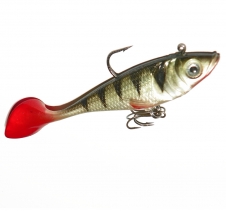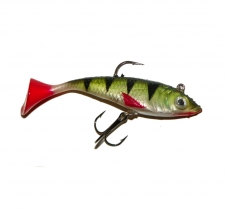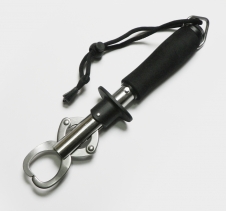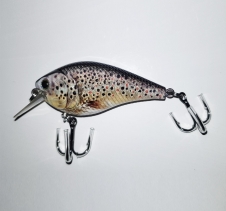Visit Our Online Store! $7 AusPost Parcel Post Delivery FREE Postage for orders $45 and over!
* Shipping rates above apply to Australian Customers only
Flathead off the edge.
Flathead Fishing. Catching flathead on lures, soft plastics & bait.
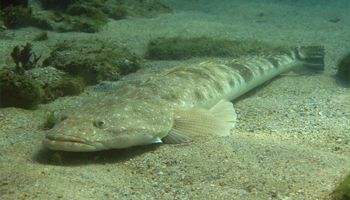 Fishing for flathead is a great passtime along the eastern sea and estuarine river systems of Australia. Flathead regularly venture into rivers, bays and ports making them easy to find, and their hunting style makes them easy to target. Let's look into the most common ways to fish for flathead using soft plastic lures.
Fishing for flathead is a great passtime along the eastern sea and estuarine river systems of Australia. Flathead regularly venture into rivers, bays and ports making them easy to find, and their hunting style makes them easy to target. Let's look into the most common ways to fish for flathead using soft plastic lures.Flathead usually camoflague themselves into the bottom of salt water systems, their body colour easily hides them as they blend in with rocks, bottom dwelling plants and detritus. They will often keep to one single location, sitting completely still or slightly hovering over, until such time as they spot their prey, once prey is within their striking distance of around 30cm, they lash out quickly to take it.
It is very easy to imitate the action of the prey in this species, the most success will likely be on soft plastic grub style lures with a decent weight ontop of them. A total weight of between 7 and 10 grams is preferred, as this allows the lure to sink quickly. Flathead fishing using soft plastics from piers and docks is the easiest, because you can drop the lure directly off the side and let it sink, after that it is just a case of jigging the lure up off the bottom until it is around 2 foot up, then let it sink again. You can move a short distance after around 10 or 15 jigs, until you find the location of a flathead. Sometimes even jigging the lure in one spot will be enough to get a flathead to sneak up and take the lure, but it is usually easier to move very slowly along piers and port docks to find them yourself.
Once a flathead is within range of your lure, it will start to figure out the best way to attack, keeping your jigging in a constant motion without big variations in the height it is being lifted and the speed will get flathead to strike faster. Once they hit it won't be a heavy one, as they strike within close distance to themselves, however if you feel a slight bump on the rod you can then position the rod vertically with a quick crank on the reel to set the hook. After this you will have a strong hold on them and can fight the fish to the surface. If it was a false alarm, simply allow the lure to sink and begin jigging again.
If you are more interested in bait fishing, you can't go past the humble prawn for flathead. Either a peeled prawn used as regular bait, sunk or floated on a medium sized hook, or if you prefer to be jigging the rod, the best method is to get small prawns and thread them onto your hook so that the prawn is no longer curled up. A live prawn only curls up when out of water, in water it is for the most part always fully extended. This can help your bait work like a lure, perfectly imitating a live prawn while also producing a prawn smell to entice the flathead even more.
Note that flathead carry poisonous spikes / barbs behind the bottom of their heads on both sides, although the usual effects of this are localised pain for up to 2 days without further complications, always avoid touching the fish near the gills. The easiest way to pick them up is using a fishing lip grip, or landing grip tool. This has two prongs which grab the lip of the fish tightly, allowing it to be held up without needing to touch anywhere near the gills, if you want to position the fish from here, you can grab the tail of the fish.
Fishing lip grips / landing grips can be used as the sole method of handling the fish, it will hold the lower lip in place while you remove the hook, you can lower the fish back towards the water as much as possible, then release the grip to place them back in the water safely for both you and the fish. Note that if you intend to keep flathead you have caught, size restrictions apply and may vary between states, always make sure you know the legal limit set by your state / territory fishing department, undersized fish must be returned to the waters unharmed.
Should you decide to keep oversize fish for eating, the process for dispatching this fish is simple, avoiding handling the fish near the gills, place the fish on a solid surface and then dispatch them using a fishing priest, strike them heavily a few times directly between and just behind the eyes. Another method can be a cheap regular screwdriver with a sharpened end in the same location, place it in hard and then move the screwdriver quickly in all directions to destroy the brain of the fish.
I prefer to keep the fish whole in cold storage without bleeding or gutting the fish, this makes it much easier to prepare for cooking later on, if the fish is whole the ability to fillet them is a lot faster, you can literally prepare the fish for cooking within 5 minutes.
To prepare the flathead for cooking, place the fish on a flat surface and hold the front of the head with your hand, turn the fish on it's side from your grip on the front of the head, don't try to handle the fish anywhere near the gills due to the poisonous barbs. After turning the fish on it's side, take a knife and without the other hand touching the fish, place the blade of the knife carefully under the fin on the side of the fish just behind the head, then cut on an angle directly towards the center of the fishes head until you touch the spine.
Once the knife is in this location turn it around so you can cut back along the spine until you almost touch the tail. Leave the skin attached to the tail for about 2cm, keeping the fillet connected to the fish for the moment. After this you can flip the fillet over and cut from the final position of the knife near the tail down to the skin, and then run the knife back up the fillet, keeping pressure on the skin to deskin the fillet, in this method you are using the connection of the skin to the tail of the fish to strech the skin out, and cutting along the skin to remove it from the fillet. You are then left with a perfect fillet of flathead with no skin attached.
If you prefer to remove the bones, the thicker front half of the fillet will have rib bones in the center. To remove these locate the bones and then lightly cut away in a straight line down along the side of the bones until you reach the bottom of the fillet, after this do the same to the other side of the bones to completely remove them. It may take a few goes to perfect this for yourself, but it is by far the best way to fillet and prepare a flathead for cooking.
Follow us on twitter: @FishTackleLures or Google Plus: +FishingTackleLuresAU
View more articles in our Australian Fishing Guide.
Enter your email address below to be updated on new fishing articles, fishing lures and special offers:
We will only email once every two to four weeks at the most, usually every 2 months.
POPULAR PRODUCTS IN OUR ONLINE STORE


